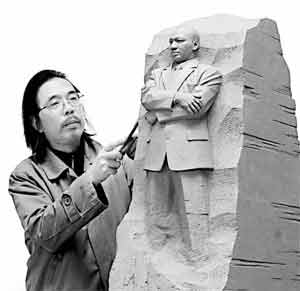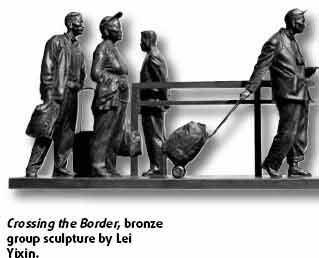Art can be a business, a profession, and for Lei Yixin, it was a way to leave the mountains where he tilled the land as an "educated youth" three decades ago.
Having stayed in the countryside for eight years after following Chairman Mao's call to receive re-education from farmers, the son of an engineer and a schoolteacher would have done anything to return to an urban life.
But he would have never imagined that a skill he acquired in desperation was to have him realize one of the greatest ambitions of artists around the world - to create the memorial statue of Martin Luther King and have it stand on the National Mall in Washington DC.
Lei was appointed a week ago by the Martin Luther King Memorial Foundation to give shape to the great man on a huge block of granite called "Stone of Hope". His work will be unveiled on the 40th anniversary of King's assassination in 2008.
The civil rights icon will stand arms folded and his head titled slightly to the right, facing the Jefferson Memorial, according to Lei's design. He is also to hold a pen in his left hand.
In the eyes of the artist who is to demonstrate his spirit, King had an unyielding spirit that made him able to shoulder great pressure. "He had so much pressure from both those who were against him and also those who were for him," says Lei.
"It was all because he was determined to pursue a goal that many ordinary people like me would believe to be too big to be the dream of an individual.
"And he decided that the goal could only be achieved in the way of non-violence, which gave him more pressure and led to his death, but in the end preached a confidence in peace in this world," says the artist.
King represents a hope that grows out desperation, and inspires people of all races, Lei says.
Lei Yixin was appointed by the Martin Luther King Memorial Foundation to give shape to the great man on a huge block of granite called "Stone of Hope".
"I can still remember the moment my father put me on his knee and we read the Chinese version of 'I have a dream' together. I was 10 at the time."
Lei was born in a family of scholars in Changsha, capital of Central China's Hunan Province. His great-grandfather, Lei Zhuhuan, was the founding president of the Hunan University in Changsha, and one of the important sponsors of Dr Sun Yat-sen in his democratic revolutionary activities.
His grandfather, Lei Tongding, was a student activist and the first Chinese to study engineering at the Moscow East Labor Communist University, which was founded by the former Soviet Union in 1920 to promote the Communism Movement in the Far East. He had lessons with Liu Shaoqi, the vice-chairman of China who was toppled during the "cultural revolution" (1966-76), and Chiang Ching-kuo, the father of modernization in Taiwan.
Because of his grandfather's experience of overseas studies, the Lei family suffered a lot during the "cultural revolution". Lei Yixin, the grandson, was sent to the mountains in Zhijiang of Hunan Province, and had no chance of returning to Changsha in spite of his hard work in the fields.
Lei almost lost hope and concluded that he would live the rest of his life like other farmers around him. But then his sister introduced him to a designer at an embroidery workshop in Changsha during one of his visits back home. Lei learned sketches from the designer by posting his works every week and waiting for comments.
When he was not working in the fields, Lei used every spare moment to practise his sketching skill and drew until the midnight almost everyday. He even managed to have his work published in the Hunan Daily, which was believed to be a big achievement at the time. But still he was not given the opportunity to leave the countryside and work at a factory or enter a college as some other "educated youths" did.
This all changed when the national college entrance exam resumed in 1977. Lei was admitted by the Guangzhou Academy of Fine Arts and became an art teacher and sculptor in Changsha after graduation. He is now the president of Hunan Institute of Sculpting.
Lei specializes in giant sculptures, and his works include those of great figures such as Chairman Mao Zedong and master artist Qi Baishi. He is known in the art world both for his realistic depiction and ability to demonstrate the spirit of a character, says Zhu Xunde, chairman of the Hunan Artists Association.
One of his most important works was Crossing the Border, a bronze group sculpture of four Chinese, including three farmers who were about to make their first visit abroad and also a customs officer. The farmers wore suits, as they supposed all Westerners dressed, but rolled up the end of their trouser legs as they did in the fields and filled their pockets with water bottles and cigarette boxes.
The farmers looked anxious and full of expectations. "I saw them when I went through the customs and traveled abroad for the first time in my life, to Malaysia, in the early 1990s," says Lei. "Almost all the people around me, and also myself, were like them."
"I thought it to be a very interesting scene. It showed a phase in China's development," he adds.
This piece of art won a national prize in 1999, and was collected by the National Art Museum of China.
Lei was recommended to the King Memorial Foundation by artists from a dozen African, American and European countries, with whom he participated in a workshop in Saint Paul, Minnesota.
The foundation was impressed by the model of King's sculpture provided by Lei, and decided it the best of more than 900 models by artists from 52 other countries.
"I suffered, so I know what suffering is," says Lei. "I can understand how the African Americans felt and I adore the hero who fought for the equal rights of all the people."
(China Daily August 2, 2007)



